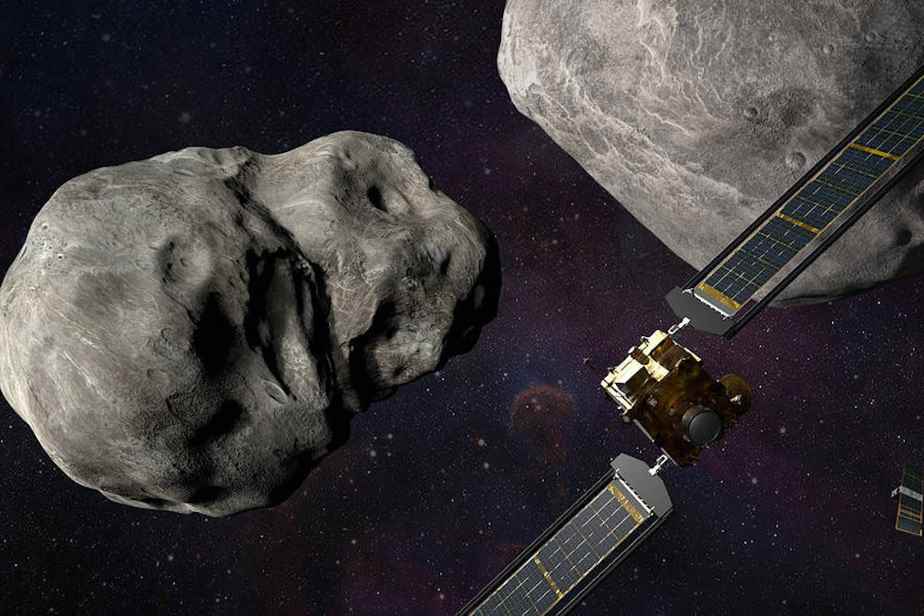The probe DART from NASA succeeded in its mission: to hit the asteroid Dimorphos to deflect its trajectory. A Quebec engineer was at the controls of the piloting.
Posted at 7:25 p.m.
Updated at 7:45 p.m.
“I shed a tear at the last moment,” said Julie Bellerose, who leads the navigation team that guided DART towards its target, an asteroid 160 meters in diameter which is in orbit around Didymos, a larger asteroid.
Mme Bellerose got flowers from her colleagues. “The navigation was perfect,” Elena Adams of Johns Hopkins University, the mission’s chief engineer, said at a press conference. M’s taskme Bellerose and his team of seven people were to give the indications to the operators of the probe so that they hit their target.
The goal of NASA’s Double Asteroid Redirection Test (DART) mission is to measure how much Dimorphos’ orbit around Didymos will have changed after the collision.
The 12-hour orbit should change by at least a few minutes, at most by half an hour. A series of ground and space telescopes scan the binary asteroid Dimorphos-Didymos to calculate the impact of DART. This tactic could be used to deflect an asteroid threatening Earth.
The collision was also filmed up close by a small Italian satellite, the light Italian CubeSat for asteroid imaging (LICIACube), which was ejected from DART September 12. “Forty minutes before the impact, our Italian colleagues told us that it would make a pass three hours later to properly capture the plume created by the impact,” said University astrophysicist Ed Reynolds at a press conference. Johns-Hopkins, who runs the mission. The first pictures of LICIACube should be available in the next few days. A European probe, Herashould closely inspect Dimorphos in 2026 to find out for sure.
17 meters
According to Mme Bellerose, the objective was to knock Dimorphos into a target 50m in diameter at its center. Eventually, the error from the center of Dimorphos was 17m, according to Reynolds. DART is smaller than a car. Dimorphos is currently located 11 million kilometers from Earth.

NASA PHOTO, PROVIDED BY AGENCE FRANCE-PRESSE
The asteroid Dimorphos just before it was hit by the probe DART from NASA.
Mme Bellerose has been working for three years on the navigation of the probe launched ten months ago. Previously, she worked on three Japanese, European and American missions to asteroids. Is it a coincidence? “My doctorate was on asteroids”, explains in an interview with The Press the one who also worked on the final phase of the Saturnian mission Cassini, in 2017.
Mme Bellerose, who grew up in Montreal, participated in the last contest for Canadian Space Agency astronauts in 2017. She made it to the last stage, when there were only about 30 candidates left. “It would have been a great heartbreak to choose between my dream as an astronaut and my career at NASA’s Jet Propulsion Laboratory,” she said in an interview. I started dreaming of being an astronaut when Julie Payette went into space in 1998 when I was a teenager. »
pile of stones
DART crashed into Dimorphos at 20,000 km/h at 7:14 p.m. The growing images of the target were received on Earth with a 38-second delay. Scenes of jubilation in NASA’s control center greeted the end of transmissions from DART.
Early data shows Dimorphos is a clump of stones rather than a hard asteroid, according to Carolyn Ernst of Johns-Hopkins, who is responsible for analyzing data from the collision. She thinks the collision will have created a 10 to 20 meter crater.
Since the gravity is low, it will take a long time for the collision plume to fall.
Carolyn Ernst, research scientist at Johns-Hopkins
Until recently, asteroids like Dimorphos and Didymos were assumed to be solid. But the Japanese Hayabusa mission in 2005 and the Osiris-Rex mission in 2020 showed that asteroids thought to be full are in fact clumps of rock.
Learn more
-
- 25,000
- Number of near-Earth asteroids larger than 150 meters in diameter
SOURCE: NASA
- 10,000
- Number of Near-Earth Asteroids Greater Than 150 Meters in Diameter Identified So Far
SOURCE: NASA
-
- 10km
- Diameter of the asteroid that signed the death warrant of the dinosaurs 65 million years ago
SOURCE: NASA
- 20 meters
- Diameter of the asteroid that injured nearly 1,500 people in Siberia in 2013
SOURCE: NASA

